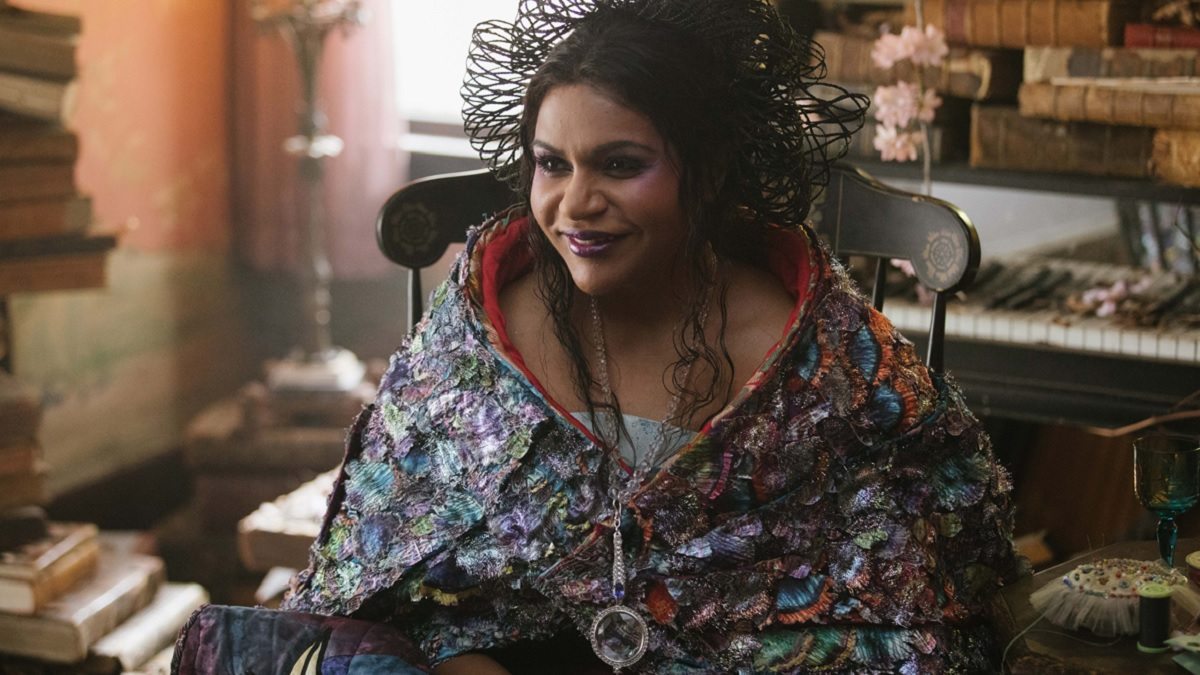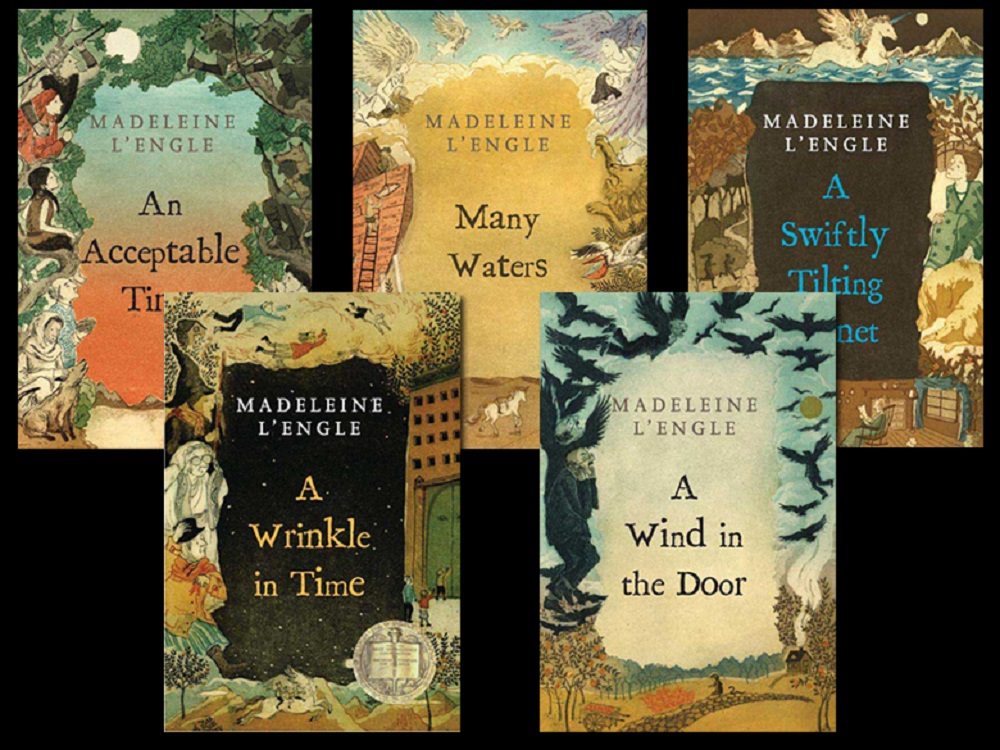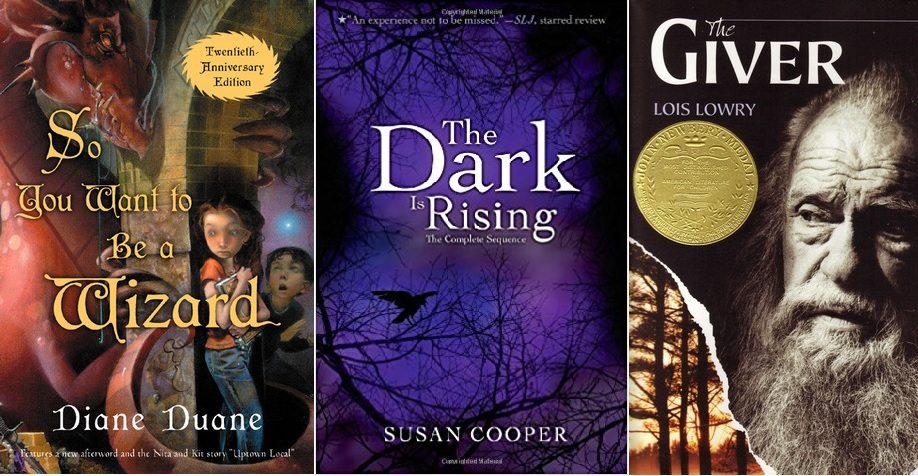
After two and a half months, it’s time to wind down my series on my favorite-book-turned-new-Disney-movie, because A Wrinkle In Time the Movie is out in the world, and I hope I’ve convinced you not to let the cynics of the world discourage you from seeing it. More importantly, I hope you’ve been inspired to read it again, or more closely, or at all. And I especially hope such a reading has left you wanting more!
But where to start when you want to read books in the same vein as A Wrinkle In Time? Wrinkle is a…unique book. Read-alikes are hard to come by.
I hope I can offer you a little guidance, at least, here.
What happens next for the Murrys?

I regret to break to you that we never do find out exactly what the Mrs Ws were in such a hurry to get to at the end of A Wrinkle In Time, but the Murry family is not done traveling through time and space and interacting with possibly-angelic beings whether Mrs Ws or not.
Your natural next step is toward the rest of the books in what is often called “The Time Quintet”—not a series in a traditional, chronological sense, but five stand-alone books about the descendants of Alex and Kate Murry continuing to wrinkle time.
A Wind In the Door, taking place a year after Wrinkle, is the most similar to Wrinkle in style and appeal. This time the travel is through inner-space instead of outer: inside Charles Wallace, in fact, whose mitochondria have developed a degenerative illness that is way more complicated than simple biology. There is telepathic communication, a being or beings who is somehow singular and plural at once, and meditations on the importance of calling things by Name.
The other three books in the “Quintet” are decidedly more YA than the first two.
- When I tried A Swiftly Tilting Planet in fourth grade, it went mostly over my head. It involves Charles Wallace jumping across centuries on the eve of a nuclear war with the help of a time-traveling unicorn, and to be honest I’m still not entirely sure what happened in it.
- When I tried Many Waters after that, I was so not ready for it. I didn’t get past the first chapter, and still felt not-quite-ready for some of it when I tried again as a teen. This book let the Murry twins have an adventure for once, sending them back in time to befriend the family of the Biblical Noah just before the Biblical Flood, a setting full of angels and demons and creepy things.
- I didn’t read An Acceptable Time until I was in college so that one at least I was ready for. It stars Polly O’Keefe, eldest grandchild of the Dr. Murrys, wandering through interdimensional weak spots that allow ancient Native Americans and Druids to interact with each other and with the modern world, and having to deal with UGH Zachary Gray (seriously one of the most unlikeable characters you will ever encounter. That’s not a problem with the book, per se, it’s just that Zachary Gray is so undeniably The Worst that I can’t mention him without groaning).
So exactly how much of the Time Quintet a newly-made Wrinkle fan might want to dive into depends a little on how old they are, and how deep they want to get.
But An Acceptable Time overlaps into another not-quite-series of books, these ones following the otherwise not-quite-as-spacetime-warping adventures of Meg and Calvin’s kids, particularly Polly. Dragons in the Waters, despite its fantasy title, is a straight-up mystery Polly (then spelling her name “Poly”) and her next younger brother, Charles, encounter on a ship to South America, and is another one more middle grade than YA that your younger fans can enjoy.
A House Like a Lotus on the other hand, which takes place just before An Acceptable Time chronologically (and first introduces Polly to Zachary “The Worst” Gray), is clearly a YA coming of age, and deals with rather problematic sex and career planning and not a drop of SFF elements, so it’s really not a Wrinkle in Time read-alike at all.
The Arm of the Starfish, which technically takes place first chronologically of all the next-generation O’Keefe family offshoots, is also YA, but a bit more accessible to younger readers. It’s a story of international intrigue with just a touch of science fiction, and though it involves the O’Keefes, the main character is Adam Eddington, marine biology intern. If I were to rank the Murry-O’Keefe books by how much I, personally, enjoyed them, Starfish would be third, after A Wind in the Door. But Adam brings us out of the “kairos” books, as L’Engle called them, and into the “chronos,” which leads me to the next section:
Expand your L’Engle Library!

As a child, I never bothered with the “chronos” books. I was into the more adventure-based genres, and L’Engle’s non-Murry-O’Keefe books looked too much like romances for my tastes, and the one that didn’t threaten to be a romance had the incredibly boring title of Meet the Austins.
A college friend set me straight, and I soon discovered that the Austin family books, though more realistic and occasionally romance-tinged than the Murry-O’Keefes, are even more consistently enjoyable reads. When Madeleine L’Engle died, I wrote in my journal, “I know I’ve always identified with Meg Murry, but at the moment I am feeling absolutely Vicky-Austin-like.”
The Austins do tend to deal a lot with grief, but they also deal a lot with joy. Meet the Austins begins with a tragic plane crash, leaving a young family friend orphaned—and for the next year, she makes her home with the Austins, a large and loving family that now needs to learn to adjust to someone with a different sort of family experience in their midst, not to mention the grief issue. Meet the Austins actually contains my absolute fallback passage about grief, a conversation Vicky and her uncle have on page 27-28 of my hardback, a passage about sympathy and empathy that is too long to quote here but made me, at the age of 18, feel suddenly understood on the subject.
Meet the Austins is the only one of the Austin books I would categorize as middle grade over YA, but the rest are a younger sort of YA that could be enjoyed by younger fans, too. This series continues:
- The Moon By Night is a road-trip story that does contain Vicky’s first encounters with romance, although one of those would-be suitors is (the first appearance of) the odious Zachary Gray.
- The Young Unicorns does not, actually, contain any unicorns, though there is a mad scientist and a…not really a genie. It’s a strange story about the year the Austins spend in the city, encountering gang violence and drugs and, um, not genies.
- A Ring of Endless Light also slips in a tiny bit of speculative fiction by way of dolphin telepathy and is without a doubt my second-favorite L’Engle book. If you read only one other book by Madeleine L’Engle, make it this one. You do not need to have read any of the others, even though this book is also about grief and joy and welcomes back both Adam Eddington (yay!) and Zachary Gray (boo!). It is gorgeous and heartwrenching.
- Troubling a Star can’t achieve that level of intensity, but it is an enjoyable adventure and Vicky goes to Antarctica so how can you not love it?
She has stand-alone books (or mostly stand-alone: she has a habit of giving side characters in one book cameos in others), as well, some YA and some adult—dramatic, philosophical, and far less speculative than Wrinkle. Whether they would be to your taste is hard to say. Truth be told, not all of Madeleine L’Engle’s books are to my taste, and I named my daughter after her. But she earned the distinction of being my favorite author because, whether I technically like what I’m reading or not, she always makes me think. She has a way of weaving the entire universe into each sentence, making the personal feel cosmic and the cosmic personal.
Adults who appreciate her voice and love to ponder the Big Questions will enjoy her nonfiction as well: collections of essays on writing, family, religion and spirituality. The Crosswicks Journals, beginning with A Circle of Quiet, are probably the most universal place to start; or Madeleine L’Engle Herself: Reflections on a Writing Life, a handy digest of quotes and passages from across her essays and speeches.
Actual A Wrinkle In Time Read-Alikes, Maybe

Being that Madeleine L’Engle has written such a variety of books, most of them not even that much like Wrinkle, perhaps closer read-alikes can be found by other authors. But L’Engle has a unique voice. Where else can you find a story that mixes so many diverse elements, fantasy and science and religion and family and friends and coming-of-age? And strikes the right chords doing it? (I say that because I think Philip Pullman kind of hits on those themes but comes up with a completely different result. He’s kind of an anti-L’Engle, to be honest).
I’ve settled on three series I feel confident in recommending to any Wrinkle-lover, as they come closest to capturing that same alchemy, though in their own ways.
The Young Wizards series, by Diane Duane: This series, beginning with So You Want to Be a Wizard is the missing link between A Wrinkle In Time and Harry Potter. If Madeleine L’Engle had written Harry Potter, she would have set it in New York City, taken out the organized school setting (except as an occasional scene for our protagonists to encounter bullies), given magic a somewhat scientific basis and an undercurrent of Universalist spirituality, kept her magic users in the world of non-magic-users (albeit with interstellar travel on occasion), and… well basically did what Diane Duane did, and continues to do, in this series that hits every one of my L’Englesque literary needs (it was no surprise to see Duane cite Wrinkle as a major influence on her series in this article earlier this year).
The currently ten books of the series were written over several decades, though they take place over only a few years, so recently Duane released the “New Millenium Editions” through her own e-book publisher, rewriting the books just enough to streamline the timeline, remove inconsistencies, and change glaringly out of date technological, medical, and social references. These new editions are currently only available in electronic format, so if you’re starting from scratch and that works for you, head over to her website, Out of Ambit. Otherwise, you can survive the mild inconsistencies in the print run and still fall madly in love with the series, as I have. I’m fairly convinced magic actually does work exactly as the Young Wizards universe says it does, and no matter what the context I now refer to the personification of evil as the Lone Power in my daily life.
The Dark Is Rising sequence, by Susan Cooper: A straight-up fantasy series that weaves Arthurian legend and a somewhat more pagan spirituality into the lives of contemporary (at the time of publication) British kids. The series officially starts with Over Sea, Under Stone, but one could also start with the eponymous second book, The Dark Is Rising, as the two books introduce two separate groups of characters that only meet in the third book (excepting the enigmatic Merriman Lyon). The series is strictly middle grade in the sense that the somewhat old-fashioned tone never deals with teenage thoughts and feelings, but it’s genuinely scary for any age. The fourth book, The Grey King, won the Newbery Medal thirteen years after A Wrinkle In Time did, and speaking of such:
The Giver series, by Lois Lowry: 31 years later, Lowry gave us another Newbery Medalist about a dystopian community very much like Camazotz in its false-peace-through-conformity, and another young hero who refuses to conform. The entire series of books, though, takes the reader through three different communities, each with their own ideas about how best to survive, each with young heroes questioning the status quo and ultimately helping to tie the communities together. Lowry asks the Big Questions, too, exploring how to balance the needs of a community versus the needs of individuals, rationality and emotion, tradition and change. You can’t read any of The Giver books without finding yourself thinking afterward, either.
On Books That Mention Wrinkle
I can’t make this list without the book which is the only Newbery Medalist to have included a previous Newbery Medalist as a plot point. When You Reach Me, by Rebecca Stead, is chock full of A Wrinkle In Time. The main character, Miranda, carries her beloved L’Engle-autographed copy around with her wherever she goes, which is something not even I can claim to have done. But even time travel is much more down-to-earth in the world of When You Reach Me than in Wrinkle—a straight-line inevitability that can’t be changed (or can it?). It’s historical realism with the slightest touch of science fiction—SF-realism if you will.
I thought of this while my kids and I were reading the All The Wrong Questions series the other month. Throughout the series, Young Snicket pays for taxi service with “tips” of book recommendations. Most of the time the recs are short and incomplete, making a guessing game for well-read readers as to which books he may be referring to, but once he got so excited to recommend a particular book that he couldn’t help rambling out almost the entire plot. I laughed. “You know what book he’s talking about?” I asked my kids. At that point we hadn’t gotten far the one time I’d tried to read them Wrinkle, and we hadn’t yet seen the movie, so they didn’t know without prodding, but it tickled me that he’d picked that book to be that excited about, rather than something closer to the genre of his own series, like The Westing Game (which is another absolutely excellent Newbery Winner that my kids thoroughly enjoyed after we finished all the Lemony Snicket, but even though the author designed the first cover of Wrinkle, it’s not a read-alike either).
I have seen many authors slip references to A Wrinkle In Time in their otherwise-not-related books. Though when I tried to think of more specific examples, all I could remember was some Baby-Sitter’s Club book, exact title lost in time, when pulp-mystery-loving Claudia had been assigned to read Wrinkle for school and, to her own surprise, found herself thoroughly sucked in. I wondered if anyone had ever collected a list of references to Wrinkle found in other works, but so far all I can find are lists of the references to other works made in Wrinkle.
But I know they’re out there. As mixed a reaction as A Wrinkle In Time can stir in people, those who love it, love it tirelessly. Many authors can’t help gushing out their raving fannishness, even when their own writing style is completely different.
Maybe they have to proclaim the influence Wrinkle has had on them directly, because it’s too hard to capture that influence through imitation.
Who can write like Madeleine L’Engle? She had a one-of-a-kind voice and vision, and I for one am eternally grateful that, for all the publishers’ rejections, all the readers who just didn’t get it, and all the people who’ve tried to ban it, she never gave up sharing that voice and vision with the world.


